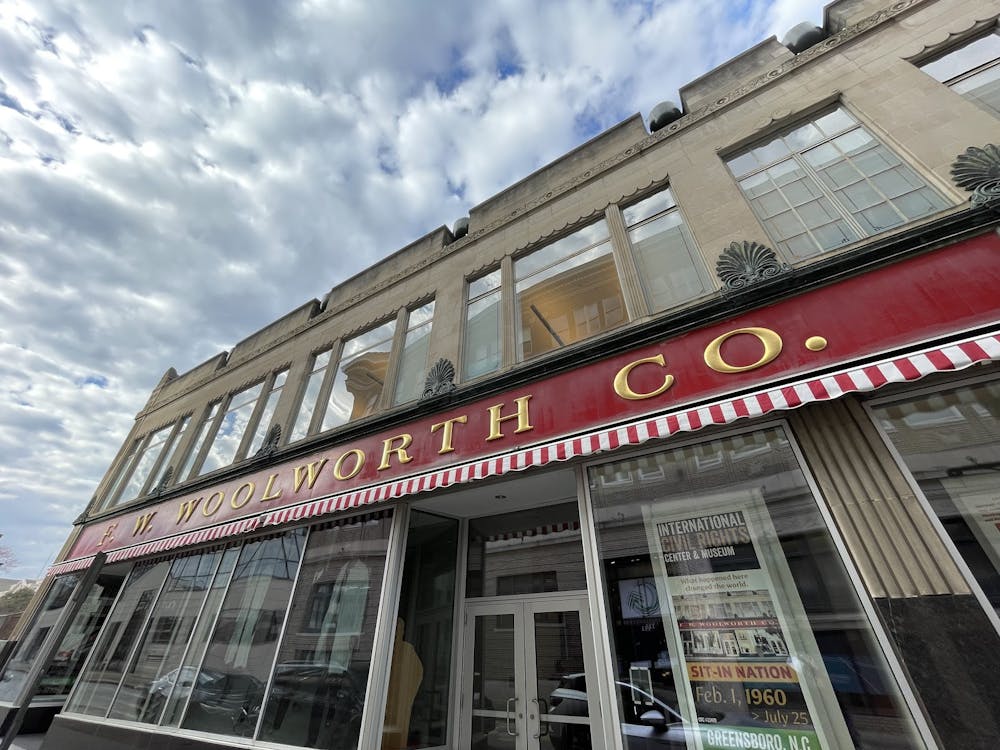Built on the site of the 1960 Woolworth’s lunch counter sit-in, the International Civil Rights Center & Museum stands at the heart of Greensboro, N.C. as a testimony to the arduous fight for civil rights. It shows a lengthy history of how a seed of bravery spurred a nationwide movement and made breakthroughs in the progress of democracy that continues to this day.
“[This] is a place that goes deep in terms of the history of Black people in this community,” said Will Harris II, Principal Scholar at the International Civil Rights Center & Museum (ICRCM). The museum sits on “Parcel No.1 of Guilford County” — the number one block of Greensboro. This was one of the blocks that used to have slave cabins, according to Harris.
ICRCM’s building is modest in size, yet its relatively small physical scope is made up for by the immersive exhibitions and dramatic narratives of its tour guides. The staff-guided tours take visitors on a journey from the Declaration of Independence to slavery to segregation, and finally, to where the civil rights movement is now.
The museum takes viewers back to Feb. 1, 1960. On that day, four young men, Franklin McCain, Ezell Blair Jr. (later known as Jibreel Khazan), Joseph McNeil and David Richmond, sat down at the Woolworth’s lunch counter until the store closed, amidst threats and heckles from others. They came back the next day and the following, each day with more people. Their efforts inspired others and were echoed in other cities. By the end of the summer of 1961, an estimated 70,000 people participated in similar demonstrations. This came to be known as the Sit-In Movement.
Though it might be hard to understand today, the sit-in was radical at the time. By barring Black customers from sitting at the lunch counters, “they excluded [Black people] from [access to] business and common encounters,” said Harris. Sitting down at a whites-only lunch counter defied societal expectations that Black and white people were not to interact except in situations within well-defined power dynamics. “This [was a] strategic choice of the demonstrators to make the biggest difference with one single action,” Harris said.
Today parts of the lunch counters at the Woolworth’s site are kept in their original 1960 décor, with 1960s prices for menu items. The Woolworth's store closed in 1993 and was subsequently purchased. It became the International Civil Rights Museum Center & Museum in 2010.
ICRCM expands upon the Sit-In Movement, giving a comprehensive understanding of what segregation meant in people’s lives. “It was all about keeping people separate," docent Cassandra Williams said. This system of segregation seeped into all aspects of southern life – education, employment, healthcare, traveling, public amenities and unequal voting registrations.
However, the museum not only immerses viewers in a past filled with oppression, but also celebrates Black people’s progress and achievements such as the Mutual Life Insurance in Durham and creative enterprises like Motown Records.
A central part of the museum's mission and vision is to prompt further advancements in social justice to continually tear down existing walls between people. In this light, the museum grounds itself in a legacy of struggles for civil rights and looks to the future. It is seeking recognition as a UNESCO World Heritage Site. Furthermore, Sit-In Movement, Inc., the non-profit that owns the museum site, acquired the five-story building immediately next to the original Woolworth’s building in 2022. With this purchase, ICRCM is now more than ever poised to keep the memory and the momentum of the Sit-In Movement alive by blueprinting a more humane future.
ICRCM’s future expansion centers around the “New Constitution” concept. The museum is actively developing exhibitions and initiatives to articulate what this country would look like if the promise of the civil rights movement – full citizenship and equitable access to resources and social contacts for all people— was fulfilled. “If the 14th Amendment [of the Constitution] were true, what would the world look like around us?” said Harris. “We have the capacity to translate ideas into pictures people have never seen before. We want this museum to be a museum of future constitutional reality.”
This new body of the center will highlight the bilateral influences of national and international civil rights movements. According to the ICRCM’s case statement, the expansion will “build out the ICRCM’s intersection of national, international, and regional perspectives on civil rights as the key to innovative and humane community at all levels.”
The museum envisions that the “New Constitution” concept in its full-fledged form would serve as a compass for America and global communities to build a society where everyone has the right to full, equal citizenship and social justice.
Get The Chronicle straight to your inbox
Signup for our weekly newsletter. Cancel at any time.
Katherine Zhong is a Trinity junior and local arts editor of The Chronicle's 119th volume.

